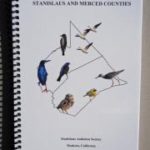 In, “How to Really Learn the Birds,” we offered a method that greatly simplifies learning the common local bird species. With the recent publication by Stanislaus Audubon Society of, “The Birding Sites of Stanislaus and Merced Counties,” learning the birds has gotten even easier.
In, “How to Really Learn the Birds,” we offered a method that greatly simplifies learning the common local bird species. With the recent publication by Stanislaus Audubon Society of, “The Birding Sites of Stanislaus and Merced Counties,” learning the birds has gotten even easier.
The fundamental strategy for really learning the birds is simplification. Almost any field guide has a least seven-hundred species, not to mention the various plumages of adults, immatures, males and females. Even worse, species like gulls can have four different basic plumages as they mature from fledglings to adults. Many warblers have distinctly different spring and fall plumages. All in all, a glance at the bewildering variety of birds and their plumages is enough to discourage even the most ardent bird lover.
Fortunately, using a couple of simple methods makes learning the birds much easier. In, “How to Really Learn the Birds,” we discuss the target method. In essence, using the target method involves studying a bird prior to looking for it in the field, then searching for the bird in its proper habitat. There are several advantages to the target method, one of which enables the beginning birder to actually learn two or even three species while targeting one key species.
“The Birding Sites of Stanislaus and Merced Counties,” provides two additional critical kinds of knowledge, status and distribution. Status simply tells us how common or rare a bird is. Distribution tells us where and when it is most often found. Using the target method is much easier once you understand status and distribution because now you not only know where to look and what to look for, you know when your target bird is present.
In addition to listing birding sites and the birds that can be found at the sites, “The Birding Sites of Stanislaus and Merced Counties,” contains a bar graph showing the relative abundance of all 310 species of Stanislaus County birds and when they are in our region. The graph contains a wealth of local knowledge expressed in a very simple format. It features the accumulated knowledge of local birders as well as all that is known about historical records compiled by people like the late Charles Feltes.
Using the site guides and bar graphs, you know what to look for, and where and when. The bar graphs also enable beginners to readily correct errors. For example, many beginners see Cedar Waxwings in our region and misidentify them as Bohemian Waxwings. A quick look at the bar graphs shows that there is only a historical record of Bohemian Waxwing, but Cedar Waxwings are abundant from October through April. Thus, when you see a Waxwing, the statistical probability that it’s a Bohemian Waxwing is almost nil.
Experienced birders are hyper-aware of status and distribution. In part because they’ve already put most of the common and uncommon local species on their lists, veteran birders are always on the alert for the presence of a rare or super-rare bird. They also realize that in the event they do see a super-rare bird, they will have to very carefully document its presence, either with careful notes or a photograph, and preferably both.
Equipped with a good field guide, binoculars and, “The Birding Sites of Stanislaus and Merced Counties,” you can quickly learn to identify 100 species of local birds. You will know you’ve acquired the requisite knowledge when you begin looking forward to the fall arrival of White- and Golden-crowned Sparrows and can’t wait to visit the San Joaquin River National Wildlife Refuge in spring, when you can hunt for Blue Grosbeaks and Lazuli Buntings.
The, “Birding Sites of Stanislaus and Merced Counties,” features art and photography by Fumiko Amano, Joe Devine, and Jim Gain. It can be purchased at The Chartreuse Muse, 918 10th Street, Modesto, or The Great Valley Museum, on the corner of College and Stoddard in Modesto. It can also be purchased directly from Stanislaus Audubon. Email editor and Stanislaus Audubon President Sal Salerno at bees2@sbcglobal.net to purchase by mail. Cost is about $12.00.
